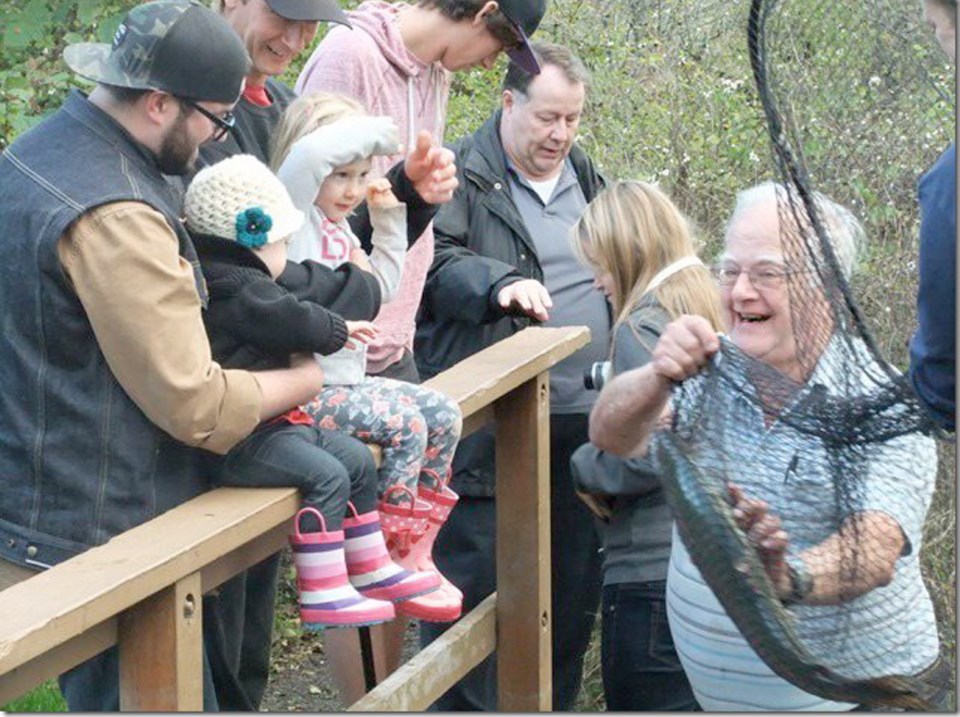George Armstrong has lived on the Gorge for 16 years, but he’s never seen the coho salmon jumping like they have in the past few weeks. From his patio overlooking the water’s edge near Tillicum Road and Gorge Road, Armstrong began seeing signs of life around 2011.
“That year, we saw two small fish jumping. I’d never seen a small fish [there] before. The next year, we saw probably 100 small fish jumping. Last year, maybe 1,000. And this year, I’m sure it’s easily 10,000.”
The numbers are anecdotal, but reports of lively jacks — smaller male salmon that mature and spawn a year earlier than the typical three-year cycle — are common, said Colquitz River steward Dorothy Chambers. She and others believe several factors, including watershed cleanup and education, have contributed to the rise in coho counts in recent years.
Salmon journey from the ocean to the streams where they were born in order to spawn. For these coho, it means waiting in Portage Inlet until there’s enough rain to make the Craigflower and Colquitz creeks strong and cloudy. “They want the water to be higher and turbid, which helps them hide from predators. Once that happens, they’ll head up either one of the two streams,” Chambers said.
Chambers has been counting coho on the Colquitz since 2000. In the first year, the average number was 200 to 400. For the last four years, the numbers have averaged between 300 and 500, with a spike to 1,400 last year. At the same time, numbers dipped in the Craigflower.
This year’s run started Oct. 22, she said, and by Tuesday afternoon, volunteers had counted 280 coho on the Colquitz. On the Craigflower, the number was higher than 700. “It feels like it will be a good year,” Chambers said.
Jody Watson, a harbours and watersheds co-ordinator for the Capital Regional District, believes education has been key. Teaching residents of the 5,000-hectare watershed how to prevent contaminants from entering the water has improved the streams’ health, while cleanup efforts on the Gorge have aided the return of eel grass, a natural habitat for some of the salmon’s food sources — in addition to providing cover for young fish on their way back to the ocean. “The Gorge used to be a bit of a sewer, it was so polluted,” she said. “Over about the last 20 years, there’s been a significant amount of work done to improve the quality of water and habitat both in Portage Inlet and the Gorge, as well as the creeks.”
Ocean survival rates — high in recent years — also affect the strength of the run, said Chris Bos, president of the Colquitz Salmon Stewardship and Education Society. Enhanced flow on Craigflower Creek thanks to the CRD’s water-release techniques played a role, too, according to Bruce Bevan of the Esquimalt Anglers. To improve flow, a valve is opened at a dam at Thetis Lake.
Stewards have been counting the fish since the 1970s. Before the water release, the creek had a tendency to dry up, killing many fish fry. Even a trickle helps keep the creek alive, Bevan said. “Now that we’ve got water in the creek, we have much better survival.”
About 20 years ago, 50 to 250 fish would have been counted in Craigflower Creek, he said. On Thursday, after heavy rainfall, 570 were counted in a single day.
However, spikes can be an indication of problems elsewhere, Bevan said. In 2012, stewards at Craigflower Creek counted 1,300 fish — likely because salmon were avoiding an oil spill on the Colquitz.
“That was a bit of an anomaly. But we expect the numbers to start being in the thousands from now on, because of the water in the creek,” Bevan said. “It’s a bit of a success story, as far as salmon enhancement goes.”



